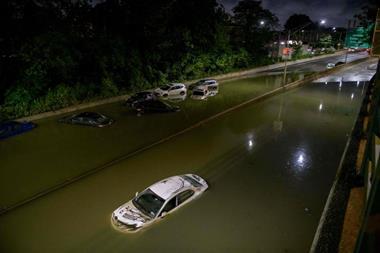Cat modelling firms peg insurance losses from the Category 4 storm at between $4 billion and $8.7 billion
Catastrophe risk modeling firm AIR Worldwide has estimated that industry insured losses to onshore property resulting from Hurricane Laura’s winds and storm surge will range from $4 billion to $8 billion.
This compares with an estimate of $8.7 billion for the US and $200m in the Caribbean from KCC, which includes the privately insured wind and storm surge damage to residential, commercial, and industrial properties and automobiles. It does not include NFIP losses or losses to offshore assets.
Laura made US landfall in Cameron, Louisiana, on 27 August with maximum sustained wind speeds of 150 mph and around 15 feet of storm surge. The storm traveled north and maintained major hurricane strength until it reached Lake Charles. The storm decayed to a tropical storm later that night. By the next day, the weather system was a tropical depression over Arkansas and then transitioned to an extratropical low as it continued east across US.
“Although comparisons between Laura and Hurricane Rita (2005) have been made, they differ in two important ways: Rita was a larger storm and hit a more populous area than Laura did,” said Dr Cagdas Kafali, senior vice president of research, AIR Worldwide. “Rita made landfall west of where Laura did, impacting population centers of Texas; Laura made landfall well east of Houston and west of New Orleans, keeping losses lower.”
After moving across the Caribbean, Laura’s rapid intensification over abnormally warm Gulf waters was similar to Hurricane Harvey (2017) and Hurricane Michael (2018), the other two most recent Category 4 or stronger storms to hit the US.
Wind damage was greatest in Louisiana, particularly in areas closer to the eyewall near landfall. Preliminary maximum wind reports from the National Weather Service (NWS) reported 133 mph gusts at Lake Charles in Calcasieu Parish. Reports show damage from torn off roofs and façades to structures that were destroyed, along with upended vehicles, damage to power lines, roads, railways, and other infrastructure.
Kafali concluded, “Residential buildings in and around Lake Charles saw significant damage to roofs of all geometries and with various roof cover types. Residential building envelopes were breached due to debris impacts and the damage was further exacerbated in many cases due to the impacts of storm surge. Residential homes in Louisiana are founded primarily on crawlspace and slab foundations, both of which are vulnerable when it comes to flood damage.”




















No comments yet